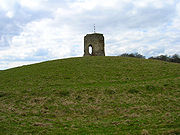
Knepp Castle
Encyclopedia

West Grinstead
West Grinstead is a village and civil parish in the Horsham District of West Sussex, England. It lies just off the B2135 road four miles northwest from Henfield.It is within the ancient division of the Rape of Bramber...
, West Sussex
West Sussex
West Sussex is a county in the south of England, bordering onto East Sussex , Hampshire and Surrey. The county of Sussex has been divided into East and West since the 12th century, and obtained separate county councils in 1888, but it remained a single ceremonial county until 1974 and the coming...
, England
England
England is a country that is part of the United Kingdom. It shares land borders with Scotland to the north and Wales to the west; the Irish Sea is to the north west, the Celtic Sea to the south west, with the North Sea to the east and the English Channel to the south separating it from continental...
near the River Adur
River Adur
The Adur is a river in Sussex, England; it gives its name to the Adur district of West Sussex. The river was formerly navigable for large vessels up as far as Steyning, where there was a large port, but over time the river valley became silted up and the port moved down to the deeper waters nearer...
and the A24
A24 road (Great Britain)
The A24 is a major road in England. It runs south from Clapham in southwest London through Morden before entering Surrey and heading through Ewell, Epsom, Ashtead, Leatherhead and Dorking...
. The name is though to come from the Old English word "cnæp", referring to the mound on which it stands.
The castle was originally a motte and bailey fortress, built in the 12th century by William de Braose
William de Braose, 3rd Lord of Bramber
William de Braose, 3rd Lord of Bramber was a 12th-century Marcher lord who secured a foundation for the dominant position later held by the Braose family in the Welsh Marches. In addition to the family's English holdings in Sussex and Devon, William had inherited Radnor and Builth, in Wales, from...
. It was rebuilt as a stone castle with a two-storey keep in 1214 by King John
John of England
John , also known as John Lackland , was King of England from 6 April 1199 until his death...
. In addition to John the castle had a succession of royal visitors, including Henry III
Henry III of England
Henry III was the son and successor of John as King of England, reigning for 56 years from 1216 until his death. His contemporaries knew him as Henry of Winchester. He was the first child king in England since the reign of Æthelred the Unready...
in 1218, Edward II
Edward II of England
Edward II , called Edward of Caernarfon, was King of England from 1307 until he was deposed by his wife Isabella in January 1327. He was the sixth Plantagenet king, in a line that began with the reign of Henry II...
in 1324 and Richard II
Richard II of England
Richard II was King of England, a member of the House of Plantagenet and the last of its main-line kings. He ruled from 1377 until he was deposed in 1399. Richard was a son of Edward, the Black Prince, and was born during the reign of his grandfather, Edward III...
in 1384. Subsequently it fell into decline and deteriorated. The bulk of it had been destroyed by the 1720s. In the early 19th century the remnants were reinforced and fenced in by Sir Charles Burrell
Burrell Baronets
There has been one Baronetcy created for a person with the surname Burrell. Another baronetcy passed by special remainder to the Burrell family....
to protect them from further deterioration.
The castle stands on an oval mound, modelled from a natural feature, surrounded by a ditch and ramparts. The ditch, fed from a nearby pond, formed a moat which still contained water at the beginning of the eighteenth century.
The surviving remains of the castle consist of a single wall 11 metres high, 9.5 metres long, and 2.5 metres thick, with a doorway and another opening above it. This wall apparently formed the north end of the west wall of a tower or keep.
The name Knepp Castle is also applied to the castellated Gothick mansion built nearby in the early nineteenth century by Sir Charles Merrick Burrell, to the designs of John Nash
John Nash (architect)
John Nash was a British architect responsible for much of the layout of Regency London.-Biography:Born in Lambeth, London, the son of a Welsh millwright, Nash trained with the architect Sir Robert Taylor. He established his own practice in 1777, but his career was initially unsuccessful and...
.

